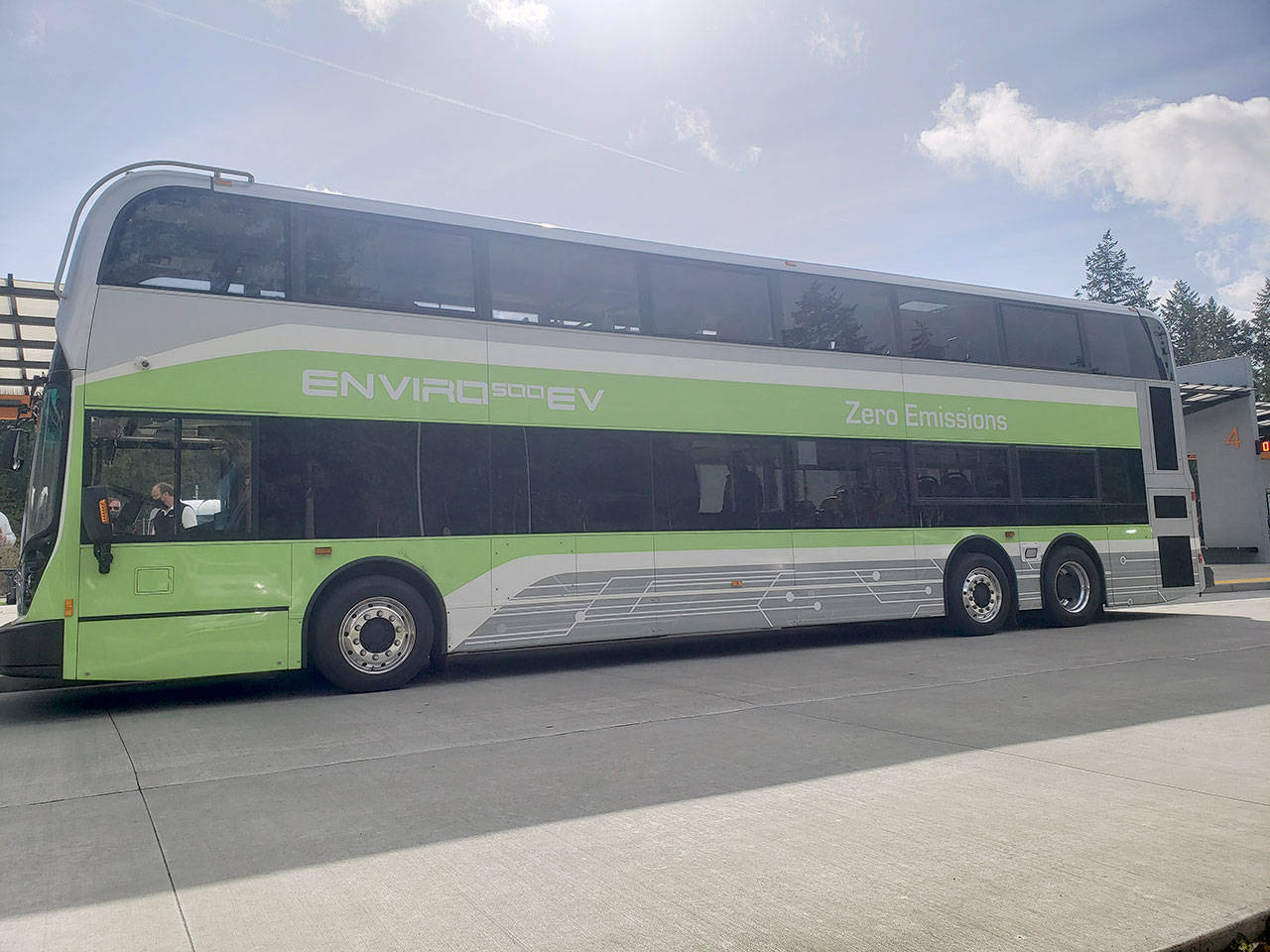As Kitsap Transit continues to transition to all-electric, the agency recently got a look at a newly designed double-decker electric bus that could serve routes between Bainbridge Island and Poulsbo.
The bus, called the ENVIRO 500 EV, is built with a lightweight aluminum body and stainless steel chassis, which optimizes weight distribution to allow for an industry-leading 648 kilowatts per hour of energy storage. The zero-emissions transit vehicle would provide about twice the capacity of a standard bus while occupying the same amount of space on the road.
“This is the way that agencies want to go,” said Stephen Walsh, vice president & general manager of British bus manufacturer Alexander Dennis. “Going to a zero-emission bus like this is the right way to travel. Our skill is to integrate components made by various people and bring it all together in one package.”
The electric vehicle will have nine battery storage packs with four under the floor and five at the rear, Walsh said. On a normal electric bus, the battery packs are stored on the roof. It will stand at 30 feet 6 inches, which is similar in height to many semi-trailer trucks.
On the inside of the bus, passengers will be provided with improved low-floor access, spacious interior, large windows, LED lighting for improved energy efficiency, heavy-duty air conditioning, individual reading lights, wireless phone chargers, wi-fi connections and multimedia passenger displays, documents say.
Additionally, wheelchair access is available through a ramp, and the bus has two wheelchair spaces. This model was designed exclusively for North America, with the first two being sold in Los Angeles.
The transitioning to electric buses began around the time that fast ferries began to be implemented throughout Kitsap County. Kitsap Transit executive director John Clauson, along with Poulsbo City Councilman Ed Stern, who used to serve on the agency’s board, have been champions of this vision since about 2014, specifically to implement from the BI ferry terminal to the North Viking Transit Center in Poulsbo.
“Not only would you be helping with congestion but you’ll also have the tourist component of a beautiful view between Winslow and Poulsbo,” Stern said. “In addition to commuters and workers, you could market it for tourism and both enhance Bainbridge Island visitation along with Poulsbo visitation.”
Stern also said that Bainbridge to Poulsbo is an ideal route to start with because it’s fairly flat terrain of only about 13 miles. He’d like to use the buses on other routes in the future. Once they’re in use, they would likely charge up at the transit center in Poulsbo.
“You can’t be dealing with too many up and down, steep hills because it discharges the battery so fast, but the run between Poulsbo and Winslow is pretty darn level,” Stern said. “These things could be frequently charged.”
Clauson said that KT also looked at articulated buses that were longer, but ultimately chose to move forward with the double-decker electric bus because it had about twice the capacity while in the same driving footprint.
“When you go to the Bainbridge Island ferry terminal, for us to bring in one articulated bus we’d have to kick two buses out,” he said. “We just can’t do that. This allows us to bring more people in with the same footprint and not require additional real estate where real estate is at a premium,” Clauson said.
“This is the only manufacturer that I’m aware of that’s producing a battery-electric double-deck bus,” he went on to say. “We looked at this a few years ago to try and determine what is the high-capacity bus of our future,” and the board concurred this is it.
Clauson is hoping to move quickly to secure a deal to bring up to 10 of the buses to Kitsap Transit. He estimated the price to be between $1.25 million to $1.5 million.
The more immediate problem is finding funding to build a heavy-duty maintenance facility at the NK Transit Center for the buses. Currently, the facility has parking, a fueling station and a bus washer.
“Once we get that facility up, then we can order these,” Clauson said. “We’re going to be moving forward with the next piece, which is the design. Once we have that design complete, then we know exactly what it’s going to cost, and then we can start going after federal funding with the construction.
“A lot of it is based on how quickly we’re able to get federal funding. We’re keeping this moving; we’re not going to let it sit on the shelf.”


